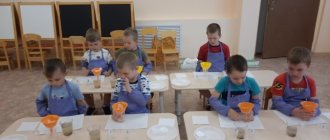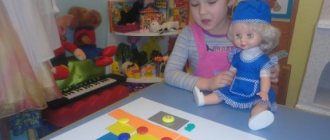The role of theatrical activities in the development of preschool children
This article reveals the importance of theatrical activities in the life of preschool children. It is the most common type of children's creativity and should occupy an important place in the pedagogical process of a preschool institution and contribute to the comprehensive development of children. The article describes the work experience of a teacher at the Katyusha kindergarten, the city of Surgut, Khanty-Mansiysk Autonomous Okrug.
Theatrical activity is the most common type of children's creativity. It is close and understandable to the child, lies deeply in his nature and is reflected spontaneously, because something is connected with the game. The child wants to translate all his inventions and impressions from the life around him into living images and actions. Entering the character, he plays any role, trying to imitate what he saw and what interested him, and receiving great emotional pleasure [7, p. 4]. The educational possibilities of theatrical activities are wide. By participating in it, children get acquainted with the world around them in all its diversity through images, colors, sounds, and skillfully posed questions force them to think, analyze, draw conclusions and generalizations. Improvement of speech is also closely related to mental development. In the process of working on the expressiveness of characters’ remarks and their own statements, the child’s vocabulary is imperceptibly activated, the sound culture of his speech and its intonation structure are improved. The role played and the spoken lines confront the child with the need to express himself clearly, distinctly, and intelligibly. His dialogic speech and its grammatical structure improve. It can be argued that theatrical activity is a source of development of the child’s feelings, experiences and discoveries, and introduces him to spiritual values. This is a concrete, visible result. But it is equally important that theatrical activities develop the emotional sphere of the child, makes him sympathize with the characters and empathize with the event being played out. Thus, theatrical activity is the most important means of developing empathy in children, i.e. the ability to recognize a person’s emotional state by facial expressions, gestures, intonation, the ability to put oneself in his place in various situations, and find adequate ways to help.
Theatrical activities make it possible to develop the experience of social behavioral skills due to the fact that every literary work or fairy tale for preschool children always has a moral orientation (friendship, kindness, honesty, courage, etc.). Theatrical activities allow the child to solve many problematic situations indirectly on behalf of a character. This helps to overcome timidity, self-doubt, shyness [4, p. 5].
The characteristic features of theatrical games are the literary or folklore basis of their content and the presence of spectators (L.V. Artemova, L.V. Voroshnina, L.S. Furmina, etc.). They can be divided into two main groups: dramatizations and directorial ones (each of them, in turn, is divided into several types).
In dramatization games, the child, playing a role as an “artist,” independently creates an image using a set of means of verbal and nonverbal expressiveness. Types of dramatization are games that imitate images of animals, people, and literary characters; role-playing dialogues based on text; staging of works; staging performances based on one or more works; improvisation games with the acting out of a plot (or several plots) without prior preparation.
In director's play, “the actors are the toys or their substitutes, and the child, organizing the activity as a “scriptwriter and director,” controls the “artists.” “Voicing” the characters and commenting on the plot, he uses different means of verbal expression. Types of director's games: tabletop, plane and three-dimensional, puppet (bibabo, finger, puppets), etc. [1, p. 24].
To successfully develop children’s creative activity in theatrical activities, a number of conditions must be met:
— create conditions for the development of children’s creative activity in theatrical activities;
- introduce children to theatrical culture;
- ensure the relationship between theatrical and other activities;
- create conditions for joint theatrical activities of children and adults.
I organize theatrical activities in the morning and evening hours at unregulated times; I organically include it in various other activities (musical, cognitive, etc.) One of the main means of developing a child’s personality is the environment. Moreover, the subject-development environment not only provides joint theatrical activities, but is the basis for the independent creativity of each child, his unique form of self-education [4, p. 7].
Thus, theatrical activities greatly captivate the children of my group with their brightness, colorfulness, dynamics and diversity. It introduces children to the theater, and they love this art; the unusualness of the spectacles that unfold by me or by the children themselves captivates children and transports them to a very special, fascinating world. Theatrical activity is not copying, but a creative process of creating images, scenery, and plays. This activity is available to children from a young age. We play theatrical games with children and they bring pleasure, joy, and cause a good mood. But this is not the only educational potential of this type of activity. Through such a game, children receive an example of friendship, truthfulness, and responsiveness through the positive characters of the play. Theatrical activities should occupy an important place in the pedagogical process of a preschool institution, promote the creative development of children, and form the basis of their personal culture [2, p. 36].
Our kindergarten operates according to an exemplary general educational program for preschool education “From birth to school”, edited by N.E. Veraksy, T.S. Komarova, M.A. Vasilyeva, supplementing it with various modern partial programs. Analyzing existing programs recommended for working with preschool children, we came to the conclusion that today, when the problem of preschool education and upbringing is being widely and fundamentally solved and the tasks facing us, teachers of preschool educational institutions, are becoming more complex, the task of introducing children to theatrical performances remains very important. activities and development of children's creative abilities.
In our kindergarten, each group has created areas for theatrical games, where rich didactic material is collected: folders “For children about the theater”, “Theater professions”, “Types of theater”, etc.; card files have been developed: “Exercises and etudes”, “Games for transformations”, “Games for actions with imaginary objects or for the memory of physical actions”, “Ri, etc. There are also card files of games and exercises for speech breathing, articulatory gymnastics, exercises for neck and jaw, games and exercises to expand the range of the voice, creative games with words. Bright albums with illustrations and pictures for fairy tales attract children's attention. Parents took an active part in the creation of theatrical corners. As a result of joint work, different types of theater emerged: finger theater, tabletop theater, shadow theater, life-size puppet theater, “Snapping Head” theater, “Funny Glove” theater, etc. A variety of materials and patterns were selected for children to independently make attributes and elements of costumes for performances .
Theatrical areas have become one of the favorite corners where children with great pleasure act out their favorite fairy tale plots, rehearse roles, and look at illustrations. All this gives children the opportunity to plunge into the world of fantasy and imagination.
It has become a good tradition in our kindergarten to hold performances for children. Children get great pleasure from participating in such events. In the process of creative activity, children’s fear of making mistakes, of doing “the wrong thing,” is overcome, which is essential for the development of courage, freedom of children’s perception and thinking, everyone is given the opportunity to feel smart, resourceful, and quick-witted.
Children's creativity is facilitated by the established contact between teachers and the parents of our students. We strive to achieve a relationship where mothers and fathers are not indifferent to their children’s creativity, but become active allies and assistants to the teacher. Together with their children, parents make costumes and scenery for performances, and teach them roles. They take part in projects that we organize together. Parents give presentations on their Theater at Home experiences at parent-teacher conferences. And also, as part of the “Theater Every Day” project, they come and, together with the children, take part in the staging of Russian folk tales. All this contributes to rapprochement and mutual understanding in the families of the pupils.
We work to develop children’s creative abilities in theatrical activities in close contact with the music director and parents. The entire kindergarten team participates in the preparation of theatrical performances: together with the teachers, we prepare scenery, posters, and develop costume sketches. Together with the music director, we select musical pieces, learn them, and work on choreographing the dances. We share our experience with colleagues. We show theater for children of younger groups.
So, one of the most effective ways to influence a child is theatrical activity, in which the principle of learning is most clearly manifested: learn by playing!
All of the above allows us to draw the following conclusions:
- During the process of theatrical play, children learn about the world around them.
- Mental processes develop.
- Speech develops.
- Motor skills are improved.
- The emotional-volitional sphere develops.
- Behavior correction occurs.
- A sense of collectivism develops.
- Creative abilities are developing.
Bibliography:
- Akulova O. Theatrical games. // Preschool education. - 2005. - No. 4. - P. 24.
- Bochkareva L.P. Theatrical and play activities of preschool children: A methodological manual for specialists in preschool education. - Ulyanovsk, IPKPRO, 1993. - 48 p.
- Koshmanskaya I.P. Theater in kindergarten (Series “Your Child’s World”). - Rostov n/d: publishing house "Phoenix", 2004. - 320 p.
- Makhaneva M.D. Theatrical activities in kindergarten: A manual for preschool workers. - Moscow. Publishing house "TC Sfera", 2004. - 128 p.
- Petrova T.I., Sergeeva E.L., Petrova E.S. Theatrical games in kindergarten: Development of activities for all age groups with methodological recommendations. — M.: School press (Preschool education and training. Supplement to the magazine “Education of Schoolchildren.” Issue 12), 2000. — 128 p.
- Tsarenko L.I. From nursery rhymes to the Pushkin Ball... - M.: LINKA-PRESS, 1999. - 160 p.
- Shchetkin A.V. Theater activities in kindergarten. For classes with children 4-6 years old / ed. O.F. Gorbunova. - M.: Mozaika-Sintez, 2007. - 144 p.
The influence of theatrical play on the development of a child’s general abilities
Play in the preschool period is the main activity of children and has a great influence on their mental development (L.S. Vygotsky, A.V. Zaporozhets, A.L. Leontyev, A.A. Lyublinskaya, D.B. Elkonin, etc. ) The term “game” summarizes various manifestations of children’s activities, which differ, first of all, in the nature of the actions and their focus - these are didactic, active, role-playing games, theatrical, musical and others. Thus, theatrical play, as one of the types of play activities, has a significant impact on the course of development of the child’s personality.
The value and peculiarity of theatrical art and its works lies in instant empathy, cognitive, emotional, communicative, vivid impact of the artistic image on the individual (A.V. Zaporozhets, A.A. Leontiev, A.N. Leontiev, Ya.Z. Neverovich) . Therefore, the role of theater in the aesthetic development of preschool children is invaluable, as evidenced by the research of A.M. Vinogradova, S.I. Merzlyakova. In the process of perceiving works of art, children develop a special type of cognition in the form of emotional images (L.I. Bozhovich, A.V. Zaporozhets). On the one hand, they reflect the external image of the surrounding world, on the other hand, the internal component in the form of sensations and ideas gives the emotional image a stimulating, activating character of reflection of the surrounding reality.
At a certain stage of mental development as a result of upbringing in preschool age, as noted by A.V. Zaporozhets, that side of aesthetic perception is revealed, which gives impetus to the development of its cognitive reality. This happens due to the fact that a work of art (visual, musical, literary) not only introduces the child to new phenomena and expands the range of his perception, but also allows him to understand his artistic image. In imaginary relationships, fairy tales, on the basis of which children’s habits and patterns of activity, aspirations and ideals, animal life and the natural world are usually formed.
The aesthetic perception of children, including the perception of theater, is not reduced to passive observation of certain aspects of reality. A preschool child has access to the internal activity of assistance, empathy, and the ability to mentally act in imaginary circumstances (L.S. Vygotsky, A.V. Zaporozhets, etc.). Older preschoolers are also able to understand the inner world of heroes and their contradictory nature. This makes it possible to use drama in the moral education of children, when various norms become significant for the child, correlating not only with a positive, but also with a negative, unattractive character (L.G. Lysyuk, S.G. Yakobson). Thanks to it, social feelings are formed, an emotional attitude to events and actions that are significant not only for the child personally, but also for those around him.
Drama is an extremely emotional activity, which makes it attractive to children. This brings great joy and surprise to the child. It contains the origins of creativity; children accept the guidance of an adult without realizing it. Theatrical activity most fully embraces the child’s personality and corresponds to the peculiarities of the development of his mental processes: Holism and simultaneity of perception, ease of imagination and faith in transformations, emotional sensitivity, not only figurative, but also logical thinking, motor activity, etc. (L.S. Vygotsky, D.B. Elkonin, etc.). This indicates the broad potential for the development of a dramatic play.




